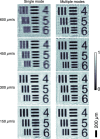Fly-scan ptychography
- PMID: 25766519
- PMCID: PMC4357920
- DOI: 10.1038/srep09074
Fly-scan ptychography
Abstract
We report an experimental ptychography measurement performed in fly-scan mode. With a visible-light laser source, we demonstrate a 5-fold reduction of data acquisition time. By including multiple mutually incoherent modes into the incident illumination, high quality images were successfully reconstructed from blurry diffraction patterns. This approach significantly increases the throughput of ptychography, especially for three-dimensional applications and the visualization of dynamic systems.
Figures





References
-
- Hegerl R. & Hoppe W. Dynamic theory of crystalline structure analysis by electron diffraction in inhomogeneous primary wave field. Ber. Bunsenges. Phys. Chem. 74, 1148 (1970).
-
- Rodenburg J. & Bates R. The theory of super-resolution electron microscopy via wigner-distribution deconvolution. Phil. Trans. R. Soc. A. 339, 521–553 (1992).
-
- Nellist P., McCallum B. & Rodenburg J. Resolution beyond the ‘information limit’ in transmission electron microscopy. Nature 374, 630–632 (1995).
-
- Chapman H. Phase-retrieval x-ray microscopy by wigner-distribution deconvolution. Ultramicroscopy 66, 153–172 (1996).
-
- Chapman H. Phase-retrieval x-ray microscopy by wigner-distribution deconvolution: signal processing. Scanning Microscopy 11, 67–80 (1997).
Publication types
LinkOut - more resources
Full Text Sources
Other Literature Sources

